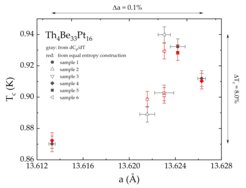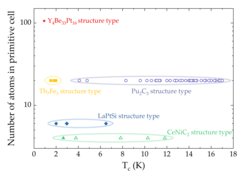A delicate interplay between crystal chemistry and superconductivity in noncentrosymmetric materials
One of the areas in research on superconducting materials is dedicated to work on noncentrosymmetric systems. The lack of inversion symmetry in these compounds opens up a possibility for unconventional pairing mechanisms. Recently, a new family of cage compounds with noncentrosymmetric cubic crystal structure (I-43d space group) was discovered [1-3]. Seventeen members of this family are based on either lanthanide or actinide elements, with the ground states properties varying from superconductivity to magnetism across the series. All of these compounds host highly-coordinated lanthanide/actinide clusters in a highly complex crystal structure with 212 atoms per unit cell. In particular, Th4Be33Pt16 is the most complex thorium-based noncentrosymmetric superconductor reported to date. Moreover, this material shows superconductivity that is strongly affected by changes in crystallographic properties. As shown in Figure 1, a small change in the value of the lattice parameter ( Δa = 0.1 %) produces a very significant change in the critical temperature Tc (ΔTc = 8%). These findings highlight the importance of detailed investigations of chemical and physical properties of lanthanide- and actinide-based materials. By studying these systems, it is possible to expand the understanding of crystal chemistry, while simultaneously providing an insight into which crystallographic parameters impact the physical properties. This work was carried out in the Laboratory of High Safety Standards, which provides an unparalleled environment for solid-state synthesis and characterization.
[1] A. Amon et al., “Y4Be33Pt16 - a noncentrosymmetric cage superconductor with multi-centre bonding in the framework“, Dalton Trans. 48, 9362 (2020).
[2] E. Svanidze et al., “Crystal structure and physical properties of novel complex noncentrosymmetric compounds R4Be33Pt16 (R = Y, La-Nd, Sm-Lu)”, Phys. Rev. Mat. 5, 074801 (2021).
[3] P. Kozelj et al., “Non-centrosymmetric superconductor Th4Be33Pt16 and heavy-fermion U4Be33Pt16 cage compounds”, Sci. Rep., accepted (2021).














